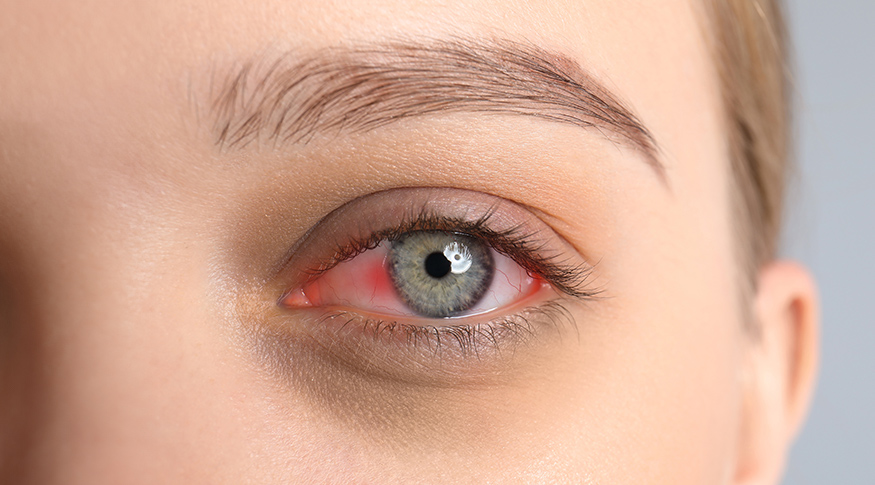
Dry eye is a common condition that occurs when the eyes do not produce enough tears or when the tears evaporate too quickly. It can cause discomfort, irritation, and even affect vision quality. At Collins Vision Care, we are committed to providing comprehensive diagnosis and treatment options tailored to each patient’s needs.

What Is Dry Eye?
Dry eye, also known as dry eye syndrome or keratoconjunctivitis sicca, is a condition that results from tear film instability. The tear film is composed of three essential layers:
- Lipid (Oil) Layer – Produced by the meibomian glands, this outer layer prevents tears from evaporating too quickly.
- Aqueous (Water) Layer – The middle layer, produced by the lacrimal glands, keeps the eyes hydrated and nourished.
- Mucin Layer – The innermost layer helps tears adhere to the eye’s surface and spread evenly.
A disruption in any of these layers can lead to chronic dryness, irritation, and inflammation, making it difficult for the eyes to remain properly lubricated.
We have successfully improved the lives of many of our patients with scleral lenses, and we can do the same for you too!

What Causes Dry Eye?
There are multiple causes of dry eye, and in many cases, it results from a combination of factors. One of the leading causes of dry eye, meibomian gland dysfunction (MGD) occurs when the oil-producing glands in the eyelids become blocked or inflamed, reducing the amount of oil in the tear film. Without a stable oil layer, tears evaporate too quickly, leading to dryness and irritation.
Other Common Causes of Dry Eye Include:
- Aging: Tear production decreases naturally with age, making dry eye more prevalent in older adults.
- Hormonal Changes: Women are more likely to develop dry eye due to hormonal fluctuations during pregnancy, menopause, or while using oral contraceptives.
- Medications: Certain medications, such as antihistamines, decongestants, antidepressants, and beta-blockers, can reduce tear production.
- Autoimmune Diseases: Conditions such as Sjogren’s syndrome, rheumatoid arthritis, and lupus can cause inflammation and decrease tear production.
- Environmental Factors: Exposure to wind, smoke, dry climates, and prolonged screen time can contribute to dry eye symptoms.
- Contact Lens Wear: Long-term contact lens use can lead to tear film instability and dryness.
- Refractive Surgery: Procedures such as LASIK can sometimes reduce tear production and lead to temporary or chronic dry eye.

Common Symptoms of Dry Eye
The symptoms of dry eye can range from mild discomfort to severe irritation and vision problems. Common symptoms include:
- Burning, stinging, or gritty sensation in the eyes
- Excessive tearing
- Redness and inflammation
- Blurred or fluctuating vision
- Sensitivity to light (photophobia)
- Difficulty wearing contact lenses
- Feeling like something is in the eye
If left untreated, chronic dry eye can lead to complications such as eye infections, damage to the corneal surface, and long-term vision problems.

How Is Dry Eye Diagnosed?
A comprehensive dry eye evaluation at Collins Vision Care utilizes advanced diagnostic tools to assess tear production, quality, and overall eye health. Key diagnostic methods include Tear Breakup Time (TBUT) to measure how quickly tears evaporate, Schirmer’s Test to evaluate tear production using a thin strip of paper under the lower eyelid, and Meibography to examine the structure and function of the meibomian glands. By identifying the underlying cause of dry eye, we can create a personalized treatment plan designed to provide long-term relief.

Treatment Options for Dry Eye
Treatment for dry eye depends on the root cause of the condition. We offer a range of treatment options designed to restore tear film stability and improve comfort.
- Lid Hygiene and Warm Compresses: For patients with meibomian gland dysfunction (MGD), maintaining proper eyelid hygiene is crucial. Daily use of warm compresses and lid scrubs helps to unclog oil glands and improve tear film quality.
- Artificial Tears and Lubricating Eye Drops: Artificial tears can help relieve mild dry eye symptoms by providing additional moisture. Preservative-free options are recommended for frequent use to avoid irritation.
- Prescription Eye Drops: For moderate to severe cases, prescription medications can help reduce inflammation and increase tear production.
- Oral Supplements: Certain omega-3 fatty acids found in fish oil and flaxseed oil have been shown to improve meibomian gland function and reduce inflammation. A high-quality omega-3 supplement may benefit patients with chronic dry eye.
- Punctal Plugs: For patients with insufficient tear production, punctal plugs can be inserted into the tear ducts to slow tear drainage, keeping the eyes hydrated for longer. This procedure is quick, painless, and reversible.
- Scleral Lenses: For severe or chronic dry eye, scleral lenses can provide significant relief. These specialized contact lenses create a protective fluid-filled reservoir over the cornea, preventing evaporation and improving comfort.
If you’re experiencing symptoms of dry eye, schedule a comprehensive eye exam today to explore your treatment options and regain lasting eye comfort.

NuLids Therapy for Dry Eye Relief
Healthy eyelids are the cornerstone of comfortable, hydrated eyes. NuLids PRO gently exfoliates and stimulates your eyelids to remove debris, biofilm, and even microscopic parasites, helping to unblock Meibomian glands and restore natural oil flow. This safe, chemical-free treatment reduces inflammation and irritation, making it an essential part of managing dry eye, Blepharitis, and Meibomian Gland Dysfunction.
Learn more about NuLids PRO and how it can help you maintain optimal eye health



